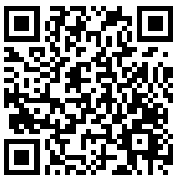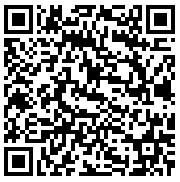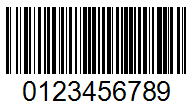
Barcode and QR code control
| Supported file types | Manually typed in text and .txt files |
| File locations | Type in a barcode number or the website address
for your QR code, Files on local or network drives (all
editions) Standard and above editions - Internet websites, www.repeatserver.com, and FTP sites Corporate and Media Wall editions - Collect barcode numbers from databases. |
| Training videos | Repeat Signage Control - QR / Barcode control (02:42 min/secs) |
Description
QR codes are seen on adverts in newspapers, magazines and on digital displays all the time and look like:

If you have a QR reader app on your smart phone, then you can just use your apps it scan the QR code with your phone's built in camera. The QR code will usually have a website address encoded within it. In the above picture of a QR code, when scanned with a smart phone it prompts the user to open the website page with their browser:
https://www.repeatsoftware.com/help/Control-QRBarcode.htm
However, you can encode more information if needed. For example:

Thanks for your interest in Repeat Signage digital signage software.
Please visit www.repeatsoftware.com for more information.
Depending on the settings, you can encode a few thousand characters if required. You can test the above with your smart phone by installing one of the many free QR code apps.
Using QR codes in Repeat Signage is very easy. When you insert a Barcode/QR control, then type in the website address that you want users to be taken to and then click on 'OK'. You only need to use the 'Barcode' tab for advanced options, or to change the colours.
One note about QR codes and digital signage. The QR code needs to be big enough on your displays to be easily scanned by a smart phone, usually from a distance of a couple of a meter or two. If you look carefully on the above QR code pictures, then second one on this page is a lot finer as their is more information encoded. This would need to be displayed slightly larger on screen so that it could be scanned easily by your audience. Always test your presentation with a smart phone after creating to make sure that your QR code can be easily scanned and also that it is taking the user to the correct website address. The easiest QR codes to scan are black ones on a white or light background. We did a test on one of our 50" True HD screens here and create a 150x150 pixel QR code. We found that this could be scanned on an old Samsung Galaxy S3 phone from up to around 2 meters away without difficultly.
Barcodes are used on all supermarket products and are scanned at the checkouts. There are over a dozen different barcode formats and we often see the EAN and UPS versions on products.

In most cases you would use this control to produce QR codes, but you also have the option of generating a barcode instead if required.
More information on QR codes and Barcodes, visit:
https://en.wikipedia.org/wiki/QR_code
https://en.wikipedia.org/wiki/Barcode
Supported barcode types
|
Symbology |
Description |
|---|---|
| Codabar | The Codabar is an old format that uses discrete, self-checking symbology, capable of encoding 16 different characters, plus an additional 4 start/stop characters. You should also specify the Start and Stop Symbols and Wide Narrow Ratio properties. |
| Code11 | Code 11, also known as USD-8, was developed as a high-density numerical-only symbology. The symbology is discrete, and is able to encode the numbers 0 through to 9, the dash symbol (-), and start/stop characters. |
| Code128 | Code 128 has been widely implemented. It is a high-density symbology which permits encoding messages of arbitrary lengths of any character of the ASCII character set. The symbology includes a checksum digit for verification. You should also specify the Character Set. The recommended setting is Auto Charset. |
| Code39 | Code 39 is also known as "3 of 9 Code" and "USD-3". It can encode uppercase letters (A through Z), digits (0 through 9) and several special characters like the $ sign. The Calculate a Checksum and Wide Narrow Ratio (which should be in a range of 2.2 -3) properties can also be specified. |
| Code39Extended | This is an extension of Code 39, also known as "Full ASCII Code 39". It is capable of encoding all 128 ASCII characters. The Calculate a Checksum and Wide Narrow Ratio (which should be in a range of 2.2 -3) properties can be specified. |
| Code93 | Code 93 was designed to supplement and improve Code 39. It is an alphanumeric, variable length symbology, providing higher reliability and density than Code 39. The Calculate a Checksum property can be specified. |
| Code93Extended | It enables encoding of all 128 ASCII characters using Code 93's "Full ASCII Mode". This is accomplished by using the ($), (/), (%), and (+) symbols as "shift" characters. The Calculate a Checksum property can be specified. |
| CodeMSI | MSI symbology, also known as Modified Plessey, is a low-density, numerical only symbology. To specify the checksum, use the MSI Checksum property. It can be set to None, Modulo 10 and Double Modulo 10. |
| DataMatrix | Data Matrix ECC200 code is a two-dimensional matrix barcode consisting of black and while "cells" arranged in a square or a rectangular pattern. The encoded information can be text or raw data. |
| DataMatrix GS1 | GS1 DataMatrix uses a special start combination to differentiate the GS1 DataMatrix symbol from the other Data Matrix ECC 200 symbols. The Bar Code control now supports this symbology. |
| EAN128 | UCC/EAN-128 symbology has the newer name GS1-128. It is based on the Code128 standard, additionally specifying the Application Identifiers for data sections within the code. It includes best before dates, batch numbers, quantities, weights and other attributes. The Character Set property can be specified (Auto Charset is the recommended value). The FNC1 Functional Character property defines a symbol that is not included in a bar code when met in text, but used to generate the application identifiers. The Human-Readable Text property, when set to Yes, inserts parentheses into the text below the bar code for better readability. |
| EAN13 | The EAN-13 barcode contains 13 digits, no letters or other characters. The first two or three digits represent the country. The leading zero actually signifies the USA, and UPC-A coding. The last digit is the checksum digit. The control calculates it automatically and it should not be present in the control's text string. So, make sure that the text for this symbology contains no more than 12 digits. If fewer digits are supplied, the string is padded with zeroes on the left. |
| EAN8 | EAN-8 is a shortened version of the EAN-13 code. It includes a 2 or 3 digit country code, 4 of 5 data digits (depending on the length of the country code), and a checksum digit. The control calculates the checksum digit automatically and it should not be present in the control's text string. So, make sure that the text for this symbology contains no more than 7 digits. If fewer digits are supplied, the string is padded with zeroes on the left. |
| GS1 Data Bar | This bar code is based on a family of symbols often used in the GS1 DataBar Coupon (coupon codes commonly used in retail). These bar codes can encode up to 14 digits, which makes them suitable for GTIN 8, 12, 13 and 14. GS1 DataBar Expanded and GS1 DataBar Expanded Stacked can encode up to 74 numeric or 41 alphanumeric characters, and provide the capability to utilize all GS1 Application Identifiers (e.g., expiration date, batch and serial number). These bar codes are often used in manufacturer coupons. |
| Industrial2of5 | The Industrial (or non-interleaved) 2 of 5 code is a numerical, low-density symbology, based on two-out-of-five code. The Calculate a Checksum and Wide Narrow Ratio (which should be greater than or equal to 2.5) properties can be specified. |
| Intelligent Mail | The Intelligent Mail (IM) code is a 65-bar code for use on mail in the United States. The Intelligent Mail barcode is a height-modulated barcode that encodes up to 31 decimal digits of mail-piece data into 65 vertical bars. |
| Interleaved2of5 | The Interleaved 2 of 5 code is a higher-density numerical symbology, based on two-out-of-five code. The Calculate a Checksum and Wide Narrow Ratio (which should be greater than or equal to 2.5) properties can be specified. |
| ITF-14 | This bar code, also known as "UPC Shipping Container Symbol", is used to mark packaging materials that contain products labeled with a UPC or EAN product identification number. This bar code provides a GS1 implementation of an Interleaved 2-of-5 symbology for encoding a Global Trade Item Number (an identifier for trade items developed by GS1). This bar code always uses a total of 14 digits. |
| Matrix2of5 | A variant of non-interleaved 2 of 5 code. It is a numerical only symbology. The Calculate a Checksum and Wide Narrow Ratio (which should be greater than or equal to 2.5) properties can be specified. |
| PDF417 |
This Portable Data File symbology is used in a variety of applications, and can also be used to generate postage accepted by the United States Postal Service. It consists of a variable number of rows, each of which is like a small linear bar code. Among other options, the Error Correction Level specifies the amount of redundancy, to protect a barcode's legibility. |
| PostNet | This symbology is used by the United States Postal Service to assist in directing mail. The code usually contains the zip-code and delivery point number. Unlike most other barcodes, PostNet actually encodes data in the height of the bars. |
| QR Code | QR (Quick Response) Code is a popular two-dimensional matrix barcode that consists of black modules arranged in a square pattern on a white background. |
| UPCA | The UPC-A barcode contains 12 digits, no letters or other characters. The first digit is the prefix signifying the product type. The last digit is the "check digit". The check digit is calculated using the first eleven figures when the barcode is constructed. So, for a correct UPC-A, make sure that the text contains no more than 11 digits. If there are fewer than 11, the string is padded with zeroes on the left. |
| UPCE0 | This symbology is a variation of UPC-A which allows for a more compact barcode by eliminating "extra" zeros. The first digit is always zero; the last digit is a checksum digit of the original UPC-A code. Not every UPC-A code can be transformed into UPC-E0. E.g., the control's text string "4210000526" is displayed by UPC-E0 symbology as "04252614" and represents the "042100005264" UPC-A code (check digit included). |
| UPCE1 | This symbology is a variation of UPC-A, which allows for a more compact barcode by eliminating "extra" zeros. The first digit is always 1, and the last digit is a checksum digit of the original UPC-A code. Not every UPC-A code can be transformed into UPC-E1. E.g., the control's text string "4210000526" is displayed by UPC-E1 symbology as "14252611" and represents the "142100005261" UPC-A code (check digit included). |
| UPCSupplemental2 | This is a supplemental two-digit barcode. Make sure that the control's text string contains two digits. |
| UPCSupplemental5 | This is a supplemental five-digit barcode, usually used to indicate the suggested retail price of a book. Make sure that the control's text string contains five digits. |
Error messages
If you pass an invalid barcode number to a barcode, you will see 'There are invalid characters in this barcode' message. QR codes accept alpha numeric data, but most barcodes expect a series of numbers instead.
A word about fonts
This control uses fonts installed on your computer. These fonts need to also be installed on the computers playing your presentations for your presentation to look correct. See Fonts in Repeat Signage for more information.